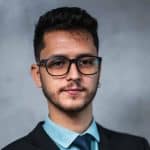Ever wondered what those long legal texts at the bottom of emails are?
Those are email disclaimers, and while they can seem like corporate mumbo jumbo, they’re actually quite useful.
They clarify privacy, protect information, and sometimes even throw in a friendly reminder to keep things professional.
You can think of them as the email’s “fine print,” setting expectations and protecting both sender and receiver.
They’re not out to get you. They are there to make sure everyone’s on the same page.
But before you dismiss them as mere boring footnotes, you have to consider that a well-crafted disclaimer can save you from a legal pickle or a social media storm.
Below, I’ll explain more about these disclaimers and how they can be helpful tools for clear communication and responsible online interactions.
- Email disclaimers are necessary to shield your online business from potential legal issues and help assure customers that you take the security of their information seriously.
- While not universally required, email disclaimers are used to manage legal risks, assert confidentiality, and clarify information contained in the email.
- Including an email disclaimer can also help you address confidentiality breaches and ensure compliance with industry regulations.
Table of Contents
PRO TIP: Take the hassle of writing your own disclaimer away with our disclaimer generator trusted by over 200,000 businesses. It’ll save you hours of work and possible costly legal mistakes.
What Is an Email Disclaimer?
An email disclaimer is a short statement added to the end of an email, typically below your signature. It informs the recipient about limitations or legal considerations regarding the email’s content, like confidentiality, security, or virus warnings.
It’s basically a heads-up to manage expectations and protect the sender.
For online businesses, a disclaimer is more than just legalese. It is a shield against misunderstandings, a silent advocate for data privacy, and a subtle brand ambassador.
It tells your customers, “We take your trust seriously, and we’re committed to protecting you and your information.”
Trust is the currency of online success, and with a well-crafted disclaimer, you’ll have a silent investment that keeps paying dividends.
Are Email Disclaimers Legally Required?
No, email disclaimers are not universally legally required. Whether or not you include one within the email depends on jurisdiction, industry, and specific circumstances.
Some countries may mandate certain disclaimers for data protection or legal purposes, but others don’t impose such requirements.
They may be optional, but many online businesses use disclaimers voluntarily to manage legal risks, assert confidentiality, or communicate specific terms.
They offer a layer of protection and clarification in various professional contexts, acting as a proactive measure to address potential legal issues.
Why Do You Need an Email Disclaimer?
You need an email disclaimer because it can help protect your online business from legal liabilities and ensure clear communication with your customers and partners.
Without one, your business could be exposed to misunderstandings, misinterpretations, or unintended legal consequences.
Here are some examples:
- If the content of your emails is misconstrued or misinterpreted, you might find yourself in legal disputes with clients, partners, or other stakeholders.
- If you provide advice in an email, it might be taken as official guidance. This can lead to misunderstandings or dissatisfaction if expectations aren’t met.
- Without a disclaimer, the terms and conditions under which your business operates may not be clearly communicated. This can result in disputes over issues such as payment terms, delivery expectations, or service agreements.
To give you more context, let’s look at the practical applications of a legal disclaimer on emails in the real world.
When to Use an Email Disclaimer
When running an online business, every email counts. But what if one wrong click or misplaced word throws your carefully crafted message into legal limbo?
That’s where a trusty email disclaimer comes in, like a mini-contract attached to your message. When exactly do you need this digital shield?
Here are the five most common situations when a business owner should consider using an email disclaimer:
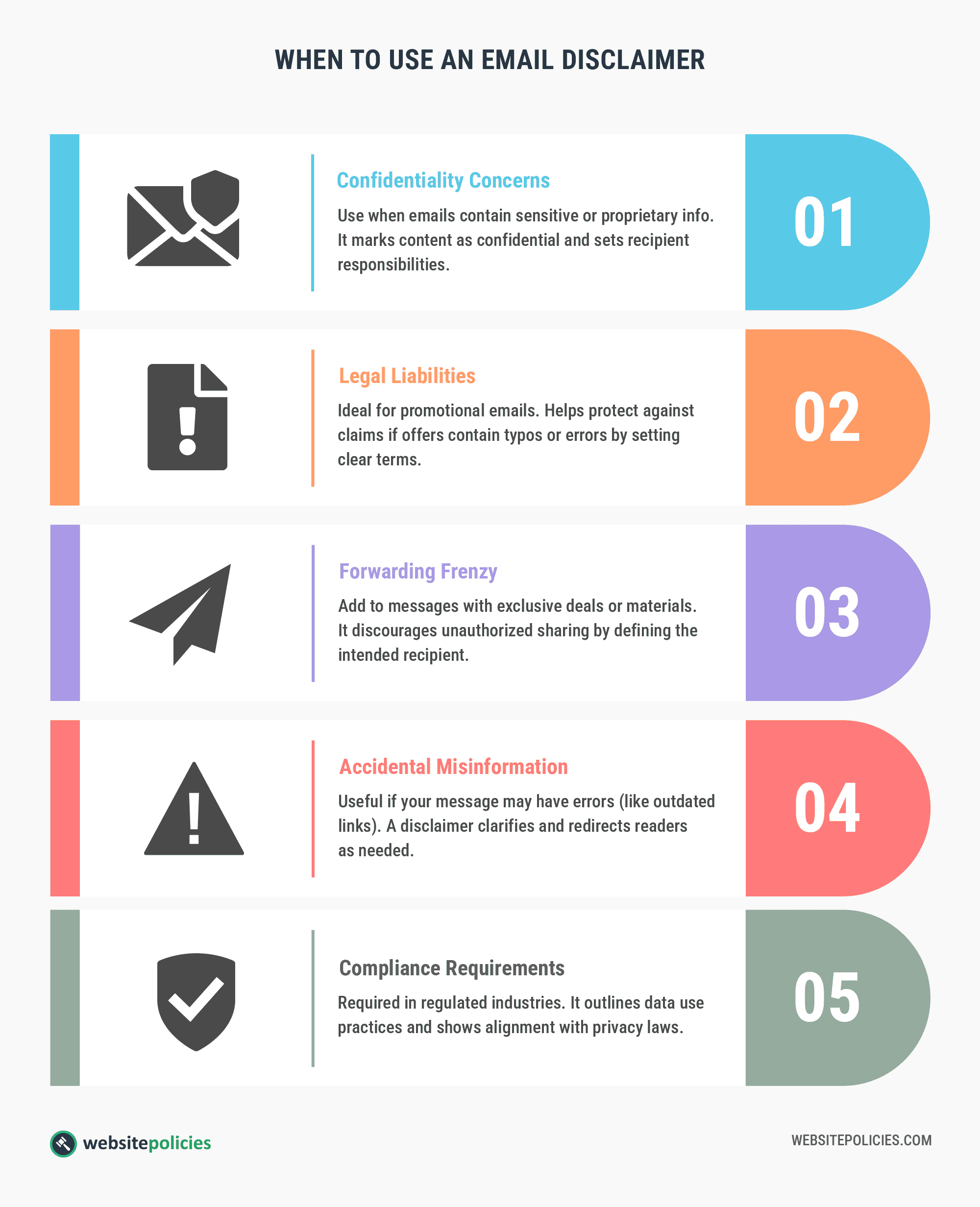
Confidentiality Concerns
Do your emails often contain sensitive customer data, trade secrets, or proprietary information? A disclaimer clearly marks such content as confidential, outlining recipient obligations and potential consequences for unauthorized use.
Legal Liabilities
If you’re sending promotional materials with special offers or limited-time deals, a disclaimer sets clear expectations, stating that information is subject to changes and errors. This protects you from potential legal challenges if, say, a typo leads to an unexpected surge in demand.
Forwarding Frenzy
Does your business share valuable marketing materials or exclusive coupons with select recipients? A disclaimer can prevent unintended dissemination, reminding recipients that the information is confidential and meant for their eyes only.
Accidental Misinformation
There are times when you may send out an email with a broken link or outdated information. A disclaimer can act as a safety net, acknowledging the possibility of errors and directing recipients to the correct source for updated information.
Picture a time-sensitive campaign with a dead link. Adding an email disclaimer can quickly guide customers toward the right path, minimizing confusion and lost sales.
Compliance Requirements
Depending on your industry or region, regulations like GDPR or HIPAA might require specific data protection measures. A GDPR or HIPAA compliant email disclaimer can help demonstrate your commitment, outlining data handling practices and recipient responsibilities.
Why Do Companies Use Email Confidentiality Statements?
Companies use email disclaimers not merely as a legal formality but more so as a strategic move in their communication protocols.
Here are the most common reasons why:
- Liability Protection: Companies use email disclaimers as a crucial shield against costly lawsuits. They inform recipients about email content, aiming to exempt themselves from legal liability.
- Risk Management Strategy: Email disclaimers, with their legal character, are important to risk management, even in countries where they may not be legally binding.
- Law Compliance and Court Evidence: In some countries, legal requirements dictate specific confidentiality notices in outbound emails. Email disclaimers can serve as evidence in court, demonstrating the recipient’s awareness of content and potential consequences in case of legal action.
- Marketing Communication: Beyond legal considerations, disclaimers serve two roles: conveying marketing messages in a cautious tone and building trust between companies and recipients. This aspect provides opportunities to promote products or services and increase lead generation and conversion rates.
While widely adopted, it’s important to note that email disclaimers aren’t foolproof for complete liability protection. You shouldn’t rely solely on disclaimers and use additional strategies to safeguard your company from unwanted lawsuits.
How Can an Email Disclaimer Protect You and Your Business?
Since email disclaimers are legally binding, at least in some countries, they can protect a company from losing serious amounts of money when the case reaches the court.
When they are legally binding, email disclaimers will make a big difference in court.
Here are several instances when email disclaimers can come to your aid:
- Large corporations can be held responsible for the content sent by their employees: When there are many employees, an organization can’t monitor every email sent by their hires. This is why big organizations use software solutions to add a custom-tailored disclaimer to any email pushed through their server.
- Breach of confidentiality: Is also another issue that can be addressed by a disclaimer. Sometimes, the email contains information intended for a specific recipient. For instance, in law firms, if the information is leaked, these firms can get into a lot of trouble. Placing an email confidentiality statement protects them from this risk.
- Virus transmission: Can return as a major lawsuit boomerang if a company doesn’t add a disclaimer telling the recipient that they can’t be held responsible if the email contains a virus. These disclaimers usually inform the recipient that the email might contain a virus and that it would be best to scan it before opening it.
- Inform a person: That he or she doesn’t have the required authority to enter a legally binding contract. This is very important, as, in some countries, emails are looked upon as written communication that can be legally binding. In the disclaimer, your company can inform the third party that the employee doesn’t have the authority to enter into a contract without a manager to ratify it.
- A company can protect itself from errors: When the content and information get misused. A well-written email disclaimer can prevent serious consequences a company might face when such an error occurs.
- When a third party relies on company advice: When the advice might lead to serious consequences, an email disclaimer can protect a company from being sued for negligent misstatement.
- Attach a specific disclaimer in the email: Some industry regulations demand that companies include email disclaimers in all email correspondence. By attaching a specific disclaimer, companies are taking care of regulatory compliance and protecting themselves from getting penalized by the state for not doing so.
Is an Email Disclaimer Legally Binding?
While an email disclaimer is not inherently legally binding, its effectiveness and legal weight vary depending on the content, context, and country. Numerous laws and specific legal situations enforce the use of email disclaimers in some instances.
Canada
The Canadian Anti-Spam Law (CASL) applies to all commercial emails sent in this country. Every email has to include the name, business, mailing address, phone number, web or email address, and an unsubscribe link.
This is why large organizations in Canada use software to add all of this information to all emails sent by their employees. Violating this law can cost organizations up to $10 million.
European Union
With the EU Directive 2003/58/EC forcing all businesses to be more transparent, we see that EU companies add disclaimers to their emails.
There are similar laws applied to the UK Companies Act, forcing businesses in Ireland, Germany, France, Italy, the Netherlands, and Denmark to include additional information in an email disclaimer.
United Kingdom
According to the UK Companies Act that was amended in 2007, every business email has to include a disclaimer that contains the company registration number, place of registration, and registered office address.
United States of America
The United States has the most complete disclaimer law. The Federal Information Security Management Act (FISMA) defines a framework to protect information and assets.
One of the standards of FISMA regulatory compliance includes the implementation of a US-authorized disclaimer in all emails.
Civil legal suits within the United States Federal Court System procedures are specified by the Federal Rules of Civil Procedure (FRCP).
A company has to provide a disclaimer here that states that the content of the email will not be subject to search to avoid the loss of a lawsuit when it is requested from them to produce the requested data.
Another federal law in the United States, the Freedom of Information Act (FOIA), is put in place to protect the information from disclosure in certain instances. This is why it is important to place a disclaimer informing the mail recipient that the email contains sensitive information that goes under the FOIA.
The Health Insurance Portability and Accountability Act (HIPAA) applies to all organizations that have access to a patient’s personal health care data. These companies in the US can use disclaimers to inform their patients about the risks related to this type of correspondence.
The Gramm-Leach-Bliley Act (GLBA) applies to financial institutions. Financial organizations have to attach disclaimers to their emails to avoid any confidentiality breaks.
There are three instances when using an email disclaimer is a must in the US: companies in the healthcare industry, financial institutions, and every company that’s under the Internal Revenue Service (IRS) regulation.
What Is Legally Required in an Email Signature?
While email signatures are often seen as mere digital introductions, they can hold legal weight in certain situations. But simply throwing your name and company logo into a template won’t guarantee your signature’s bite.
Here are the must-have components that transform your signature from a simple farewell into a miniature legal contract:
1. Business Identification
Clearly state the full legal name of your company, organization, or sole proprietorship. This establishes the entity responsible for the email content and its potential consequences.
Then, provide the official physical address of your business. This location serves as a point of reference for legal proceedings, should the need arise.
In certain jurisdictions, like the UK, including your registered company number in your signature is mandatory for legal bindingness.
2. Contact Information
Clearly state the email address associated with the sender to ensure proper identification and facilitate direct communication.
You also need to include a phone number for inquiries or clarifications. Aside from the email address, this offers a secondary contact channel and adds legitimacy to your online presence.
3. Disclaimers
If your email contains confidential data, add a disclaimer for confidential information. Outline who has access to it and the restrictions on its use or disclosure. Doing this protects sensitive data and reduces the risk of accidental leaks.
Clearly state that your email content is for informational purposes only and does not constitute legal or professional advice. This disclaimer safeguards you from potential liability arising from misinterpretations or errors in the information provided.
Lastly, if you wish to restrict the forwarding of your email, explicitly mention it in your signature. This controls the dissemination of sensitive information or confidential offers.
Where to Place an Email Disclaimer
In practice, an email disclaimer is usually attached at the end of an email message.
According to the research paper Segmenting Email Message Text Into Zones, written by Cecile Paris and Andrew Lampert, the disclaimer belongs to the bottom of the “Boilerplate Zone” of an email.
This is the part of the email that contains content that is reused in the same form across multiple email messages. So, once written, an email disclaimer will be automatically appended to this zone.
If you have ever read a part of an email that is alerting you or informing you about something important in a cautionary tone, you have read an email disclaimer.
While the common practice is to put a disclaimer at the email footer, when we look at some examples, there is some absurdity to it.
For example, think of emails that contain the disclaimer, “This e-mail message is intended to be received only by persons entitled to receive confidential information.”

If there is very sensitive information in the email, the best practice is to double-check the “Send to” field before clicking “Send.”
Attaching a confidentiality disclaimer at the end of the message just isn’t practical. It would be best to keep it short and place it at the beginning of the email.
These are so-called “Prepend Disclaimers.” Financial institutions and legal organizations quite often opt to use these.
On the other hand, Append Disclaimers are placed at the bottom of the email message body.
Some organizations prefer to place a link to the Append Disclaimer right at the top of the email to avoid unwanted problems.
How to Add Email Disclaimer in Gmail
Whether you’re a seasoned entrepreneur or a budding freelancer, protecting yourself and your business in the digital world is important. One simple yet effective way to do this is by adding a disclaimer to your Gmail signature.
Here’s how to add a disclaimer in Gmail in just a few easy steps:
Step 1: Access Signature Settings.
Open Gmail and click the Settings gear icon in the top right corner.

Select See all settings from the drop-down menu.

Step 2: Write Your Disclaimer.
Scroll down to the General tab and locate the Signature section.
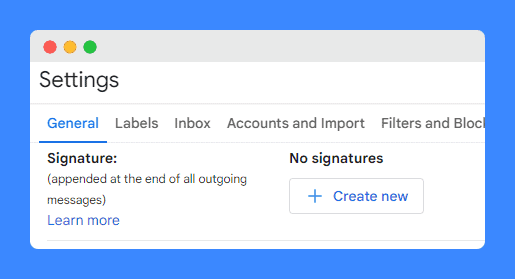
Here, you have two options. If you don’t already have one, click Create new and give it a name. If you have a signature you want to add the disclaimer to, select it from the drop-down menu.
Step 3: Add the Disclaimer Text.
In the signature editor, simply type or paste your desired disclaimer text. Here are some things to consider including:
- Confidentiality: If your emails contain sensitive information, add a legal disclaimer for confidential documents. State who can access it and any restrictions on its use.
- Limitation of liability: Specify that your emails are for informational purposes only and not legal or professional advice.
- Forwarding restrictions: If you want to limit forwarding, clearly state it here.
You can format your disclaimer for clarity using bold, italics, or line breaks.
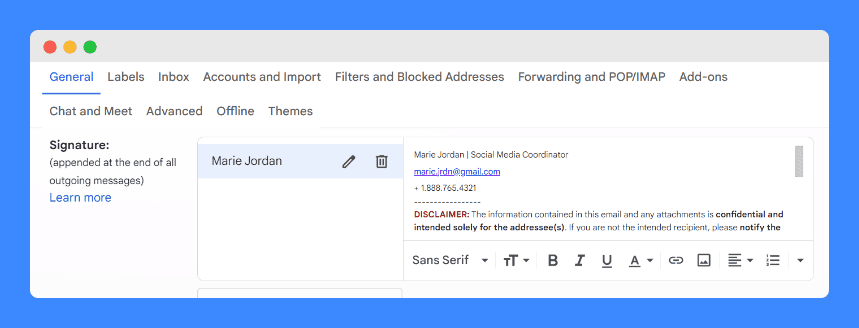
Step 4: Click Save Changes.
Once you’re satisfied with your disclaimer, click Save Changes at the bottom of the page. Now, every outgoing email will automatically include your signature and disclaimer.
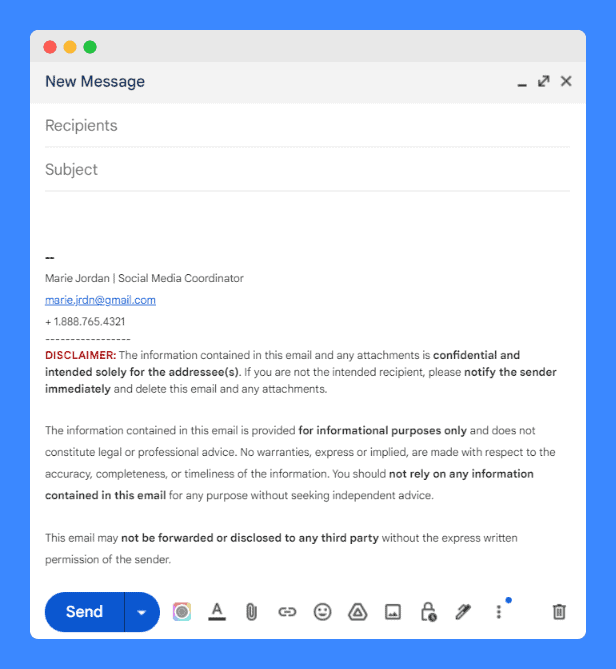
Types of Email Disclaimer Examples With Templates
The purpose behind it is, in most cases, legal. But if the purpose is not of the legal kind, then the disclaimer most probably has a marketing message behind it.
It’s worth noting that not all email disclaimers are the same. Usually, they deeply reflect the company’s policy.
Email Disclaimer for Confidential Information
The entire content of this email message is confidential. This also applies to any files attached to it. This email is intended for an individual or entity to whom they are addressed. In case you are not the addressee of this email, immediately contact the system manager. The information in this email is very sensitive, and it is intended for the specific addressee. This email should not be disseminated, distributed, or copied. If you have received this email in error, make sure to immediately notify the sender by email and afterward delete this email from your system. Disclosing, copying, distributing, or taking any action in reliance on the email content is strictly prohibited. Consider yourself notified.
Opinions Expressed Disclaimer
Views and opinions presented in this email are solely those of the email author. They don’t necessarily represent those of the organization. Our employees are explicitly required not to infringe or authorize any infringement of copyright or any other legal right by email communication, as well as not to make defamatory statements. Our company policy is clear, and you can access it here. It states that any such communication is contrary to our policy and outside the scope of the organizational role of the individual concerned. Considering all this, please be informed that the company will not accept any liability in respect to such communication. If any damage or other liability is arising, the employee is the one who will be personally liable.
Virus Transmission Disclaimer
The security of this email cannot be guaranteed and can contain viruses that may infect your computer. The recipient of this email should scan this email and any attachments included in this email. [Company Name] will accept no liability for any damage caused by any virus transmitted via this email. Emails can be intercepted, lost, destroyed, corrupted, contain viruses, or arrive late or incomplete. This is why email correspondence cannot be guaranteed to be secure or error-free. This is why the sender does not accept liability for any errors or omissions in the contents of this message, which arise as a result of the email transmission.
Non-Binding Email Disclaimer
Please be informed that no employee or agent is authorized to conclude any legally binding agreement on behalf of [Company Name] with the 3rd party via email. This can be only done if the employee or agent in question has a confirmation explicitly written by the “Company Director” for that specific occasion.
Legal Compliance Email Disclaimer
Our company cannot be held responsible for the content of this email, nor can it be responsible for the consequences of the actions taken based on the information we have provided in this mail. We accept liability only if we have subsequently confirmed the information found in the email in writing. Please make sure that you are the intended recipient of this email. If you are not, please notice that disclosing, copying, distributing, or taking any action in reliance on the contents of this information is strictly prohibited.
Unsubscribe Email Disclaimer From Newsletter
Thank you for subscribing to our newsletter. The [Company Name] team will work hard to deliver good and valuable information in the fields you specified when you were subscribing. However, in case you decide that you no longer want to receive newsletters from us, you can unsubscribe by clicking the link here.
Environmentally-Conscious Email Disclaimer
Please do not print this email unless it’s absolutely necessary. Every time you don’t print an email, you are helping the environment.
External Email Disclaimer
This email is from [Company Name] and is intended for the addressee only. If you are not the intended recipient, please notify the sender and delete this email. The information contained herein may be confidential and privileged. Do not forward without permission.
Health and Medical Disclaimer
This email may contain health-related information intended for general informational purposes only. It is not a substitute for professional medical advice, diagnosis, or treatment. Consult a qualified healthcare provider for personalized guidance. Any actions taken based on the information in this email are at your own risk. The sender and associated entities disclaim all responsibility for any consequences arising from the use of this information.
HIPAA Email Disclaimer
This email may contain protected health information (PHI) and is intended only for the named recipient. Any unauthorized access, disclosure, or use is prohibited. If you are not the intended recipient, please notify the sender and delete the email. The confidentiality of PHI is protected by federal law (HIPAA). Any views expressed are solely those of the sender and not necessarily reflective of the healthcare entity. No liability is assumed for errors or omissions.
GDPR-Compliant Email Disclaimer
This email is subject to the General Data Protection Regulation (GDPR). It may contain confidential information intended for the named recipient. If you are not the intended recipient, please notify the sender and delete the email. The processing of personal data in this communication is per GDPR principles. Any unauthorized disclosure, alteration, or distribution is prohibited. The sender assumes no liability for any errors or omissions.
Frequently Asked Questions
Are email signature disclaimers necessary?
Yes, email signature disclaimers are often necessary to clarify terms, limit liability, and ensure legal compliance in business communications.
What is the best practice for email disclaimers?
Keep email disclaimers concise, clear, and tailored to legal requirements. Include confidentiality, disclaimer of liability, and contact information.
Do email signature disclaimers work?
Email signature disclaimers can offer legal protection and set expectations. The effectiveness of email disclaimers depends on clarity, relevance, and adherence to local laws.
Are email disclaimers legally binding in all countries?
No, email disclaimers aren’t universally legally binding. Their effectiveness varies by jurisdiction. Consult an attorney for compliance in specific countries.
Do email disclaimers hold up in court?
Email disclaimers may provide some legal protection but aren’t foolproof. Courts consider context, local laws, and the disclaimer’s specificity.
